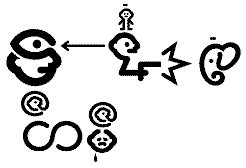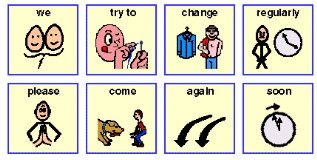 |
| If they want war then that is what they shall have. |
Blissymbolics: Probably the most fully developed and widespread visual conlang. The gimmick of Bliss is that it reduces all images to a few simple shapes based entirely on straight lines (horizontal, vertical and diagonal only), dots, circles (and semicircles), squiggles and a tiny handful of special shapes (valentines, question marks). Basic images are then combined into more complex concepts, utilizing reoccuring patterns.
For example, at left war is constructed from the battle symbol between two country symbols, each of which is constructed from the symbol for flag planted in the symbol for earth. The symbol for if and then are similar, but the question mark has shifted. Want is feeling+fire.
If you poke through their animal vocabulary, you'll see that dog is an animal symbol with an upraised tail, while wolf is wild+dog, and fox is small+wolf. Lizard is snake+animal; crocodile is tooth+water+lizard.
(see also vocabulary comparison.)
 |
the pond this evening its surface gradually blurring in the rain |
Earth Language by Yoshiko F. McFarland. Each glyph is a composite of elements that carry parts of the meaning. For example, in the haiku to the left, notice that the first and last words, pond and rain, both contain the same graphic of a droplet, meaning water.
(see also vocabulary comparison.)
 |
| Seeing elephants shot by men makes me cry. |
Elephant's Memory: by Timothy Ingen Housz. "A pictorial language consisting of more than a hundred and a fifty combinable graphic elements (pictograms and ideograms). The system presents a playful learning environment oriented primarily towards children, and provides an explorational tool enabling new approaches to the concept of language."
| A man went to a city. |
IconText by Colin Beardon. "A visual language which allows authoring of complex messages through use of relations. ``It allows a message to be read in two distinct ways - as a static hypertextual message that can be explored at leisure, or as an animation that will reveal the message as a sequence over time."
 |
Minspeak by Bruce Baker (1980) "A pictorial language system which can be learnt by children as young as two and does not require literacy. It offers tremendous advantages in accessing core vocabulary (those few hundred words that make up 85% of what we say)."
 |
| ai o efipe i o i o i folomoli i o i lilasi i lilasi i o |
| The sun is low over smooth water, a sailing-ship is near a palm island. |
Phonetic Picture-Writing by Leonhard Heinzmann. "Picture-writing also can be read phonetically, for its ideograms (picture symbols) are composed of special letters."
MUSLI: "Makes use of a broad range of media like computer graphics (2D and 3D), audio clips, speech, photographs, and animations. Because of their dynamic nature MUSLI documents are often referred to as movies. Users have the ability to stop the movie anytime, display additional information, start, rewind, fast forward, review, and resume at will."
| don't read sad books in bed. |
Interscript: by Edwin Michael Wheeler. "Interscript is a purely visual communication system based on symbols and independent of any particular language. It covers the most frequent concepts in general use and combines the principles of hieroglyphs with conventions established in modern Highway, Safety and Tourist Codes."
| In those days, I ate in the restaurant. |
Signology: by Juan Garay. "Signology is the art of writing with pictures. If pictures were suitable only to represent concrete things their scope would be very limited. But this is not the case. Pictures can be used to represent verbs and abstract concepts and therefore a whole language can be built on pictures."
This is probably the most natural visual conlang on the Web. If an illiterate English-speaking community tried to cobble together a complete graphic system of writing from scratch, this is probably what they'd come up with -- an easy hand-drawn illustration of every word.
(see also vocabulary comparison.)
 |
| The chicken got bigger. |
Universal Picture Language by Wally Flint. "A language of pictures having expressive power nearly equal to that of natural languages. The main purpose of UPL is to generate new ideas for improving other picture languages that are currently used to help people who have certain kinds of language disabilities."
It is not tied directly to a natural spoken language. Instead of strictly translating the English sentence as [definite] [chicken] [became] [more] [big], UPL creates two related statements: "An object went from small to large" and "That object is a chicken."
| peaches | |
| insect | |
| person |
Yingzi: by Mark Rosenfelder. "If English was written like Chinese." Not really a viable language; it's more of an alternate history that teaches the basic concepts of written Chinese.